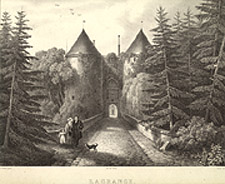 |
SERIES XXIII. HOMES—CHAVANIAC AND
LAGRANGE
The homes of Lafayette in France, Chavaniac and LaGrange, are depicted
in the prints of Series XXIII (Box 15). Chateau Chavaniac, the birthplace
of Lafayette in 1757, still stands in the province of Auvergne. Lafayette's
home later in life was LaGrange, an estate located approximately 50 kilometers
southeast of Paris, between the small towns of Courpaley and Rozay-en-Brie.
Several of the views of LaGrange in this collection are prints based on
paintings by American artist Alvan Fisher. These views were later
used ca. 1830 as the designs for the transfer-prints on Staffordshire dinnerware
created by the English ceramic company of Enoch Wood & Sons.
Examples of these Fisher scenes on ceramics are located in the Marquis
de Lafayette Memorabilia Collection (I.1,3,4,5,6,14). |